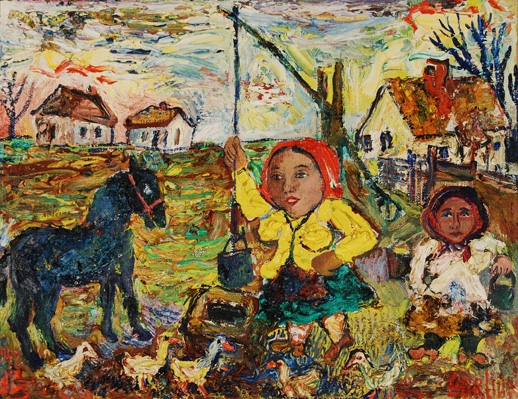"
David Burliuk: Russian Futurist," the galleryÔÇÖs first major exhibition of work from the Louis and Annette Kaufman Collection, opens in May 2008. As a painter, poet and writer of manifestos, David
Burliuk (1882-1967) was a central figure in the intellectual and artistic avant-garde of early 20th century Russia. He is sometimes called the ÔÇ£Father of Russian Futurism.ÔÇØ Burliuk was inspired by revolutionary Western European art movements ranging from Impressionism and Post-Impressionism to Fauvism, Cubism, German Expressionism, Italian Futurism and Symbolism, but also by the Orthodox religious icons and na├»ve folk art of Russia and his birthplace, the Ukraine. Art movements to which he contributed include Russian Neo-Primitivism, Rayonism and Cubo-Futurism. Burliuk participated in the influential "Jack of Diamonds" exhibitions in Moscow from 1910 to 1918, together with Chagall, Kandinsky, Larionov, Goncharova and Malevich, among others. He also exhibited in Munich in 1911 with the international Der Blaue Reiter group that included Kandinsky, Jawlensky, Franz Marc and Paul Klee. As a poet, he co-wrote the Russian Futurist manifesto, A Slap in the Face of Public Taste (1913). Born in 1882 to wealthy Ukrainian peasants, Burliuk enjoyed access to a high degree of education, with periods of study in Kazan, Odessa, Munich, Paris and Moscow. Burliuk fled Russia in 1918 during the Bolshevik revolution and spent the next four years in Siberia and then Japan. He was court painter to the Japanese emperor from 1920 to 1922 and very well received there. However, anticipating war with Russia, the Japanese government requested that he leave in 1922. He then immigrated to New York and developed his "Radio" style, a dynamic and innovative blend of Symbolism, Neo-Primitivism and Expressionism, so called in reference to the advent of radio and its ability to make available a variety of cultures. Burliuk's critical acceptance in the New World came in 1923 with a major exhibition of his paintings at the Brooklyn Museum and soon thereafter a solo show at the Soci├®t├® Anonyme ÔÇô the first museum of experimental modern art ÔÇô established in New York in 1920 by Marcel Duchamp, Man Ray and Katherine Dreier. In 1939, Burliuk moved his family from the Lower East Side to Hampton Bays, Long Island. He traveled again to Europe which prompted a series of pictures inspired by Van Gogh and by 17th c. Dutch painters such as Pieter Brueghel the Younger. With his wife, Marussia, he collected modern art and published an art magazine called Color and Rhyme (1937-66). In addition to Cubo-Futurist and Symbolist paintings, he continued creating delightful, proto-na├»ve paintings, depicting the American landscape as well as the Russian countryside of his memories. Burliuk died in 1967 and that same year was honored posthumously by induction into the American Academy of Arts and Letters. His work is in the collections of such prestigious museums as the Guggenheim, New York; the Museum of Modern Art, New York; the Whitney; the Metropolitan Museum of Art; the Brooklyn Museum; the Museum of Fine Arts, Boston; the Frederick R. Weisman Art Museum; the Phillips Collection; and the Smithsonian American Art Museum; The State Russian Museum in St. Petersburg; the Thyssen-Bornemisza in Madrid; and the National Museum of Modern Art, Kyoto.


